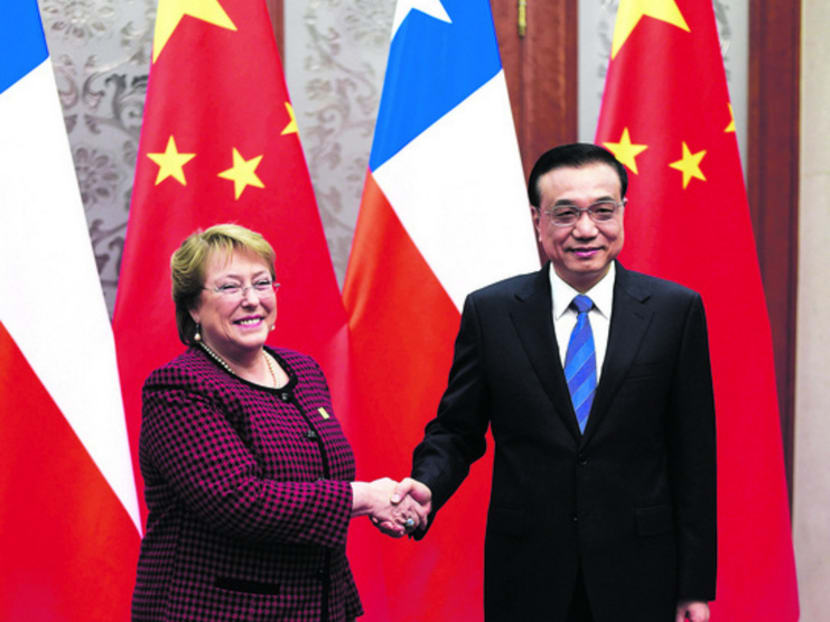Premier Li heads for South America with economic ties at forefront
BEIJING — Chinese Premier Li Keqiang starts a week-long visit to South America today, seeking to boost economic ties with Brazil, Colombia, Peru and Chile. A key objective of Mr Li’s visit is to push for Chinese-backed transportation projects, including the building of a rail link across the Andes.

Chinese Premier Li Keqiang (right) meeting Chilean President Michelle Bachelet in Beijing last year. China is keen to gain access to raw materials and investment returns, while Latin American countries are keen for an influx of Chinese cash. Photo: Reuters
BEIJING — Chinese Premier Li Keqiang starts a week-long visit to South America today, seeking to boost economic ties with Brazil, Colombia, Peru and Chile. A key objective of Mr Li’s visit is to push for Chinese-backed transportation projects, including the building of a rail link across the Andes.
“The visit, another significant diplomatic action after Chinese President Xi Jinping’s Latin America tour last year, is to promote bilateral industrial capacity cooperation, enhance political trust, and deepen cultural and people-to-people exchanges, among others,” the state-owned Xinhua news agency reported yesterday.
“Cooperation in finance, technology, aerospace, infrastructure and other emerging sectors is expected to be highlighted during Li’s visit, beyond the traditional spheres of cooperation such as mineral resources, energy and agriculture,” it added.
China’s Foreign Ministry said last week that Mr Li will be meeting Brazilian President Dilma Rousseff, Colombian President Juan Manuel Santos, Peruvian President Ollanta Humala Tasso and Chilean President Michelle Bachelet Jeria during his visit.
China has been deepening ties with Latin America in recent years. Resource-starved China is keen to gain access to raw materials and investment returns, while Latin American countries are keen for an influx of Chinese cash.
In particular, international rail contracts are a political priority for Beijing, which sees exports as a solution to China’s burdensome overcapacity in steel, rail, construction and engineering services as the economy slows. Chinese-built rail projects have been proposed for Thailand, Indonesia and central Asia.
A rail programme fits Beijing’s preference for government-to-government infrastructure deals that can be allocated to state-owned companies, which remain wary of complex Latin American tax and labour laws. China engineered a merger in its two state-owned rail companies late last year to prevent them from undercutting each other in international tenders.
The concept of a trans-Andes rail link is ambitious, with cost estimates ranging from US$4.5 billion (S$6 billion) to US$10 billion for a northern link through the Amazon. That route is almost certain to face opposition from environmental and indigenous rights groups as it would cross primary forests. A longer alternative through Peru’s southern deserts would have to include Bolivia but would justify large port investments in the south of Peru.
The Andean rail plan could tie into South America’s vision of developing more ties with Asia through the Pacific Alliance, a trade pact between Chile, Colombia, Mexico and Peru. The Chinese gripe that the plan for freer movement of goods involves few specifics.
“We’ve had trade but investment was more lacking,” says Dr Chen Taotao of the Center for China-Latin America Management Studies at Tsinghua University, noting Chinese appetite for Brazil’s resources. “Chinese companies are increasingly interested so it makes sense to build leadership ties.”
While Chile and Brazil are some of China’s biggest suppliers of raw materials, Peru is rapidly becoming a focus for Chinese investment in the region.
With US$19 billion in the pipeline, Chinese investment now accounts for about a third of new mining projects in Peru. In late 2014, state-owned oil company CNPC bought the Peruvian business of Brazilian oil group Petrobras for US$2.6 billion.
Chinese investment has, however, proved elusive in some of Peru’s neighbours. While a senior Colombian official says the two countries were working on “two very ambitious transport infrastructure projects”, other plans have yet to come to fruition. In 2011 Colombia’s President said Chinese investors were interested in a rail and port connection that would link its Pacific and Atlantic coasts. Nothing has materialised.
Beijing is still smarting from Mexico’s revocation of a US$3.75 billion high-speed rail contract after it emerged that the Mexican President’s family mansion had been built and paid for by a Mexican partner in the Chinese-backed consortium. AGENCIES





